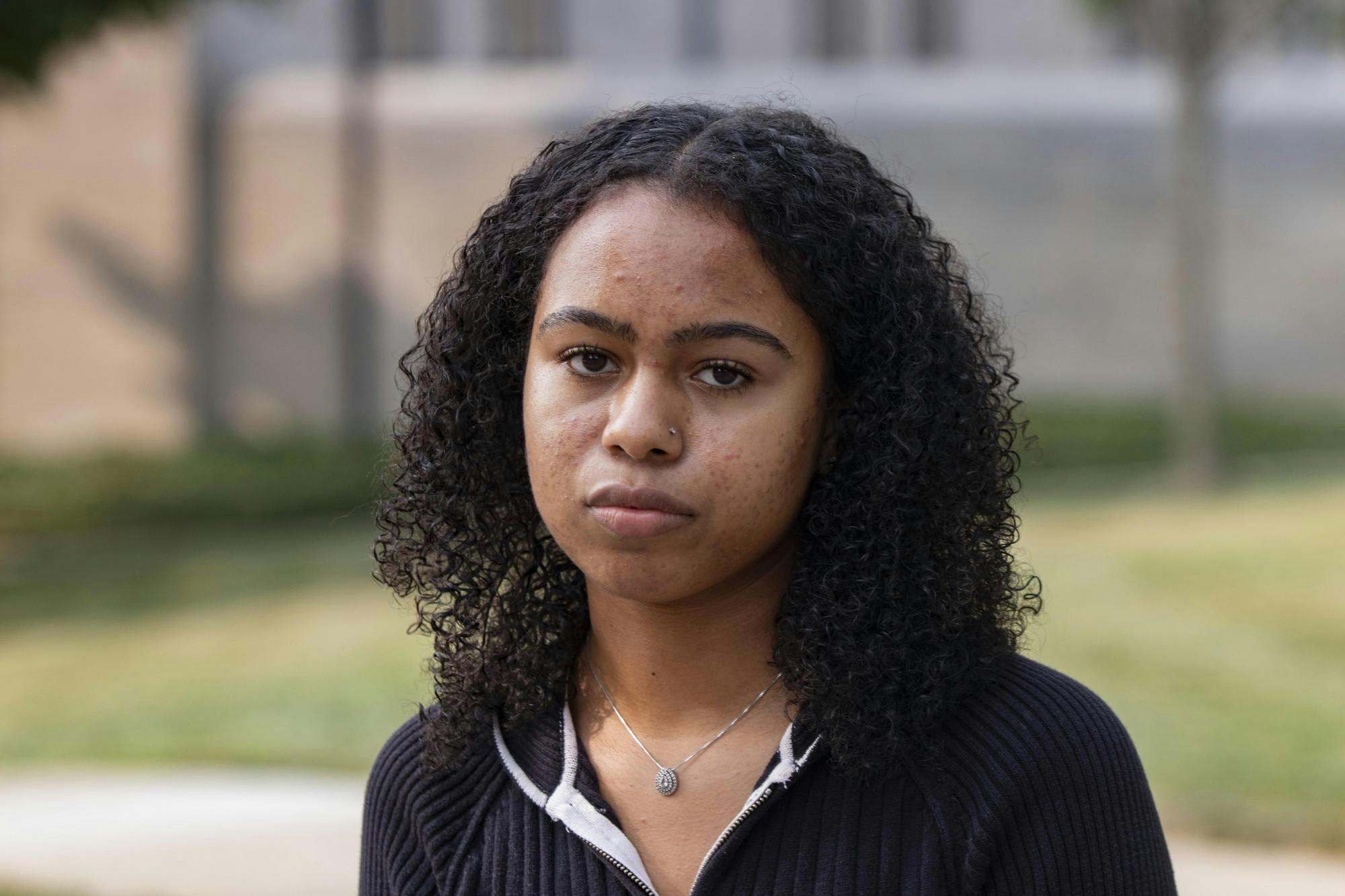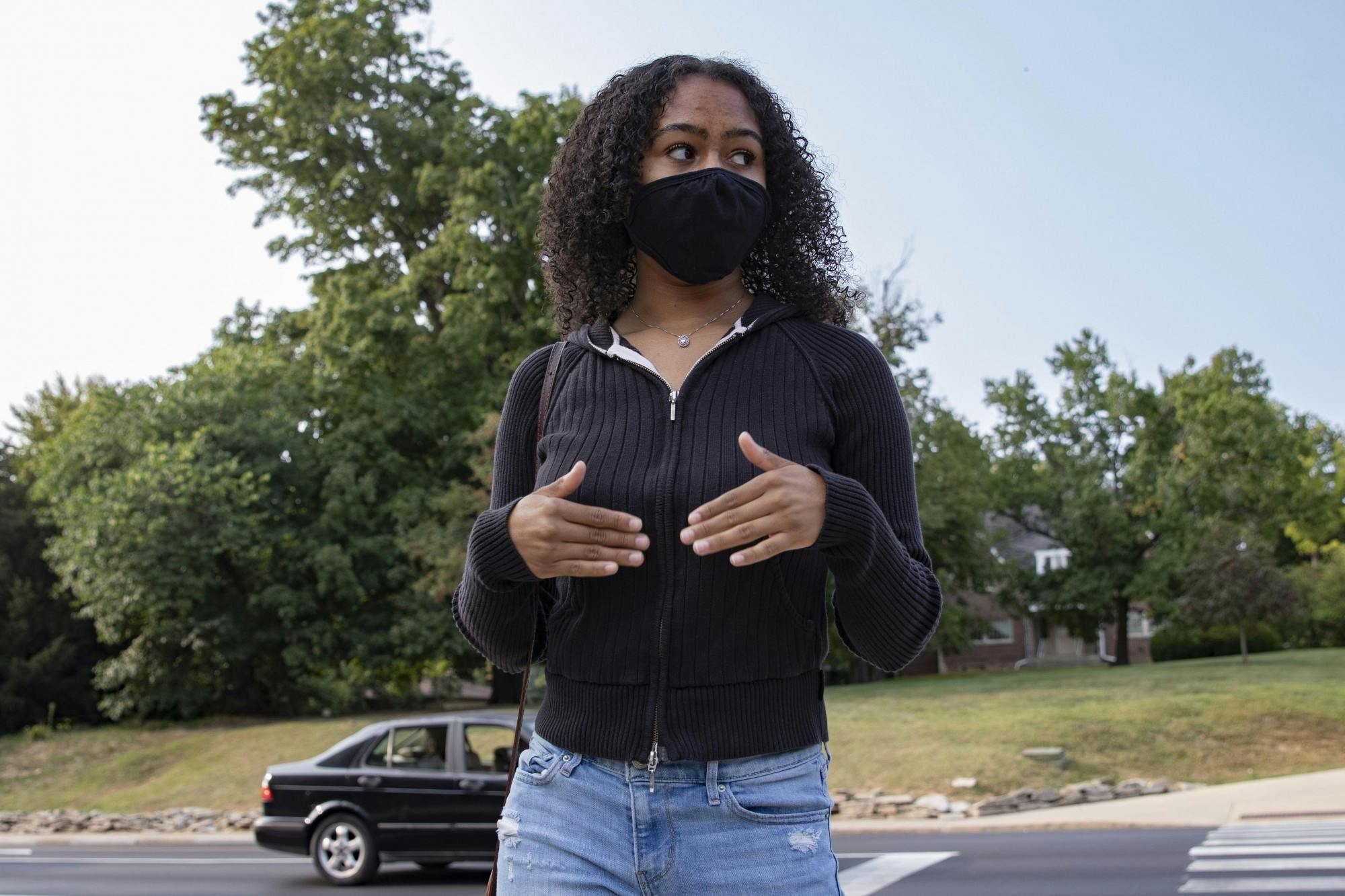She sat on her bedroom floor that Monday morning with her eyes closed in meditation. Alice Aluko’s face turned toward the November sunlight streaming through her windows as she said silently to herself: You are healthy, you are smart, you are equipped, you are protected.
The next day was Election Day, when the country would decide whether to reelect President Donald Trump. Rumors were flying online about white supremacists targeting people of color during election week, but Alice tried not to think about that. She knew being positive all the time was not a realistic goal, especially for a Black 21-year-old woman in a country where being Black takes a daily mental toll. But she could manage eight minutes of pure positivity.
The rest of the morning unfolded as most Mondays did. She opened her computer and Zoomed through through her ecology and environmental law classes. Then she headed out the door to get a matcha latte from Starbucks, feeling inside her purse for her pink taser like she always does.
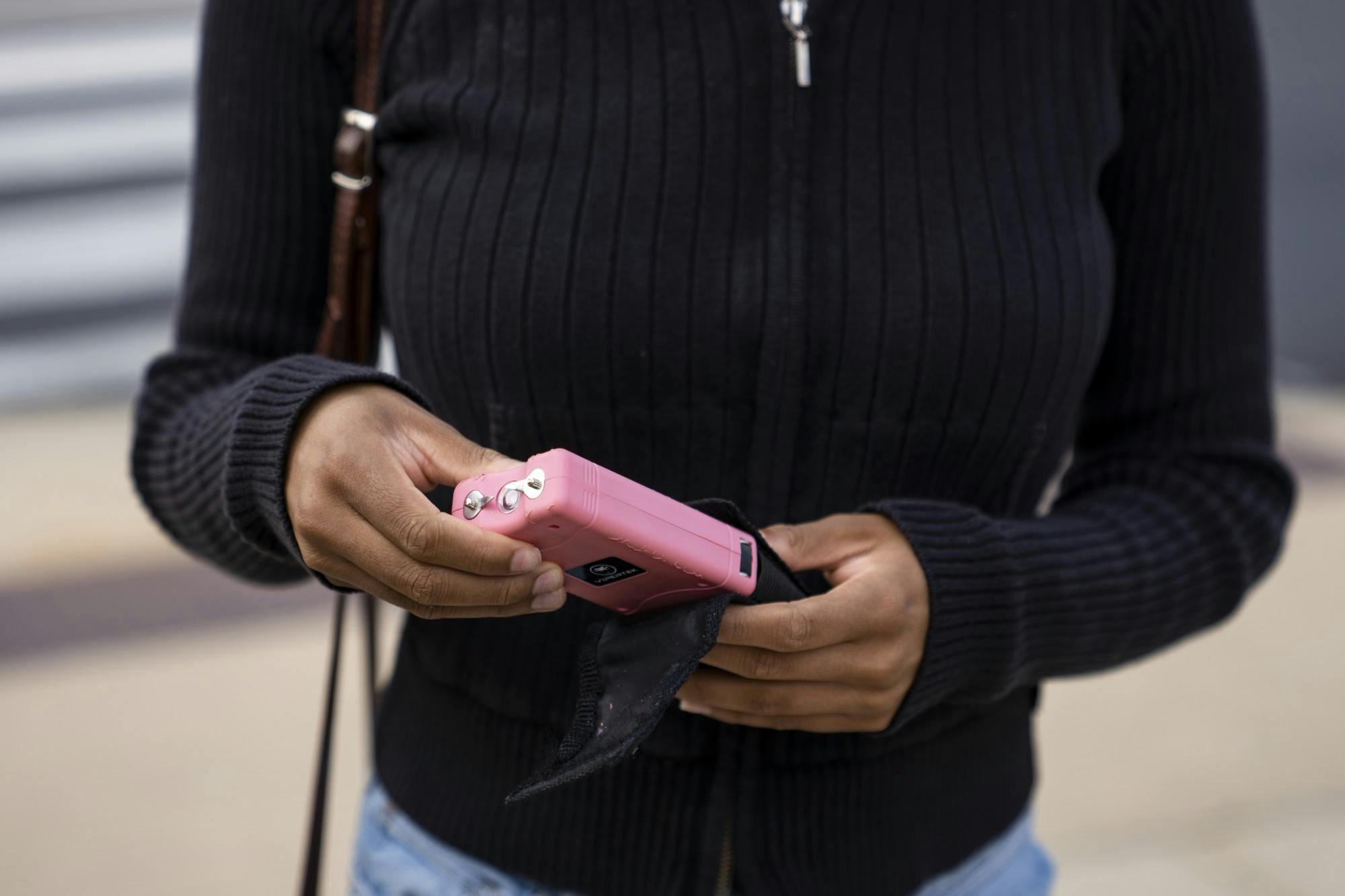
Claire Livingston | IDS
Aluko shows the pink taser her boyfriend bought her after the second incident. They can only see each other once a month, so he tries his best to protect her in any way he can.
She never thought she’d own a taser, but then again, she never thought a lot of things would happen.
When Alice was little, she wanted to be the president of the United States. She was obsessed with President Barack Obama. He had a white mom and an African dad just like her. She wrote the president letter after letter in elementary school, telling him about her life and the issues facing her community such as homelessness.
When the time came to choose her college, Alice knew she wanted to stay close to her Indianapolis home. At IU, she’d be surrounded by people from her high school, and she’d be in a good program for environmental management. It seemed like the best bet.
“The way it was sold to me was that Bloomington is super liberal and open and aware,” Alice said. “And I mean I guess. But … ”
She rolled her eyes and let out a small laugh.
***
Two years ago, when Alice started at IU, she was excited to make new friends and study what she was passionate about. She knew she was going to be a minority on campus, but she could never have imagined that she would experience two blatant acts of racism during her freshman year and countless other smaller instances on a regular basis.
Two years and an election later, the fear has not gone away. Neither has the feeling of betrayal.
IU boasts about its diversity. According to the university, the number of minority students on all of IU campuses combined has nearly doubled since 2007. But while there are now 3,080 Hispanic students and 2,973 Asian students at IU-Bloomington, there are only 1,982 Black students.
Ten percent of college-aged Hoosiers are Black. But on the IU-Bloomington campus, Black students make up only 5.2% of the student body.
IU was one of the first universities in the nation to create a way of reporting and responding to racism 32 years ago when the Racial Incidents Team was created.
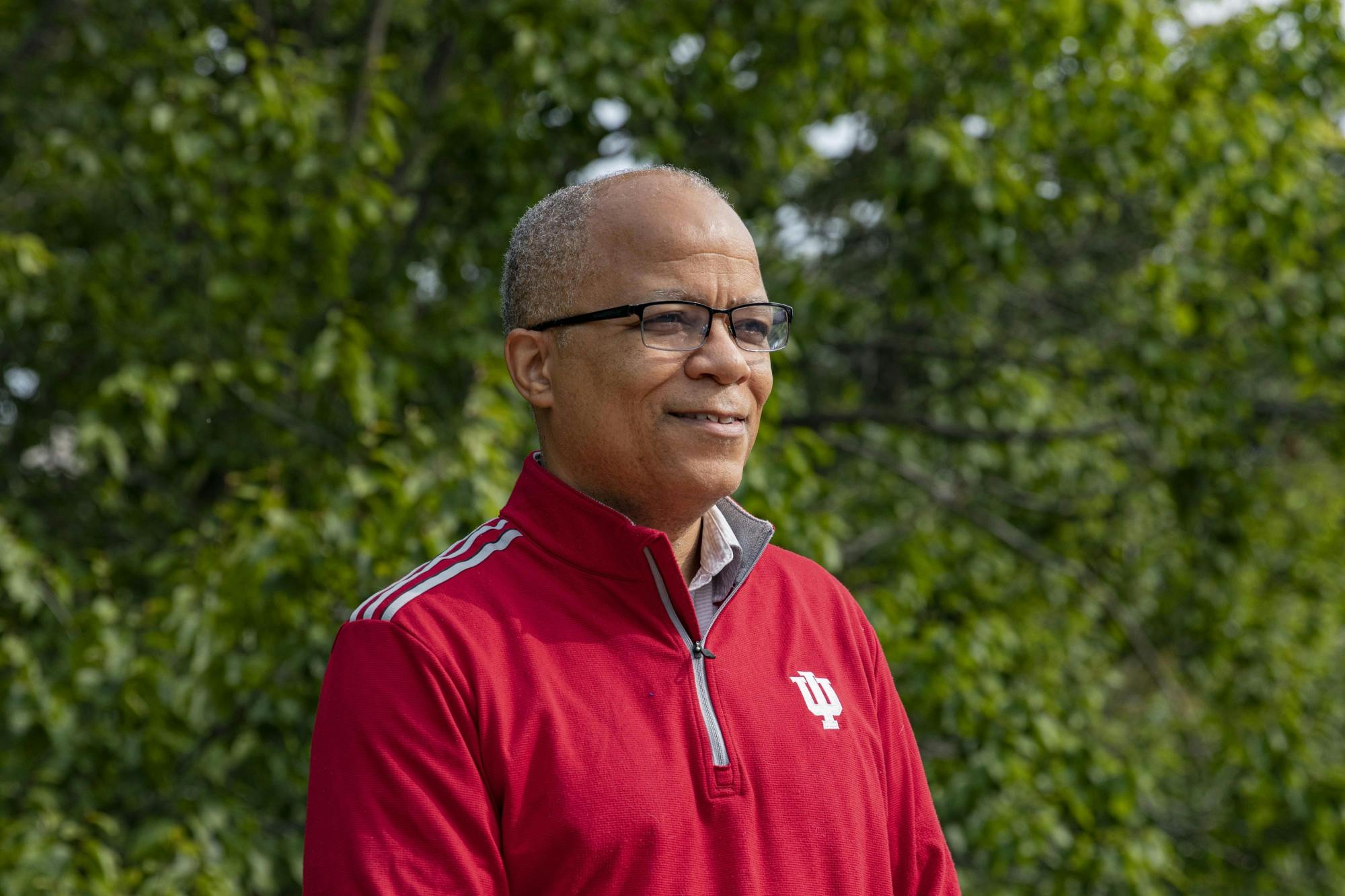
Alex Deryn | IDS
Director of Bias Response Cedric Harris poses for a portrait Sept. 14 at the Indiana Memorial Union. IU students and faculty can reports acts of bias against them to the bias incident response department.
Cedric Harris, director of bias response at IU, said racism is one of the most prevalent forms of bias on campus. He said he reads all reports submitted by IU students through the bias reporting system and responds to each one, asking if the student would like to talk through anything or take further action. But he knows there are many incidents that go unreported.
From 2018 to 2019, the annual number of bias reports more than tripled from 50 to 163. More than 200 reports are predicted to be reported in 2020 based on the amount received so far. The number of reports does not always equate to the number of incidents since multiple students may report on one incident.
Harris, 57, attributes some of the recent increase to the fact that he was hired in 2019 to specifically address bias reports as his full-time job. He said his quick responses to students and the time he has taken to spread the word about bias reporting may have led to more reports. But he wonders if other factors are at play, like the nation’s political climate.
Harris said cases most often involve student-on-student bias, but lately there have been more cases of bias in the classroom. There was one instance when an instructor reportedly told students to share their family heritage but told them not to talk about slavery. Harris said it’s especially tricky when an instructor is involved due to power dynamics. Students and assistant instructors often wait to report bias perpetrated by a professor until after they receive their final grade or are finished working with the instructor.
Although Harris’ job is to respond to bias incidents, he is limited in his power to stop the incidents from happening or punish those who commit them. The reports he gathers offer valuable data, but they do not offer a concrete solution to the university’s age old problem of racism.
Advertisement
***
In the weeks before she started her freshman year in Bloomington, Alice started getting warnings from Black people who would come through her line at Office Depot and ask about her school plans. There’s some racist stuff that happens down there, they’d tell her.
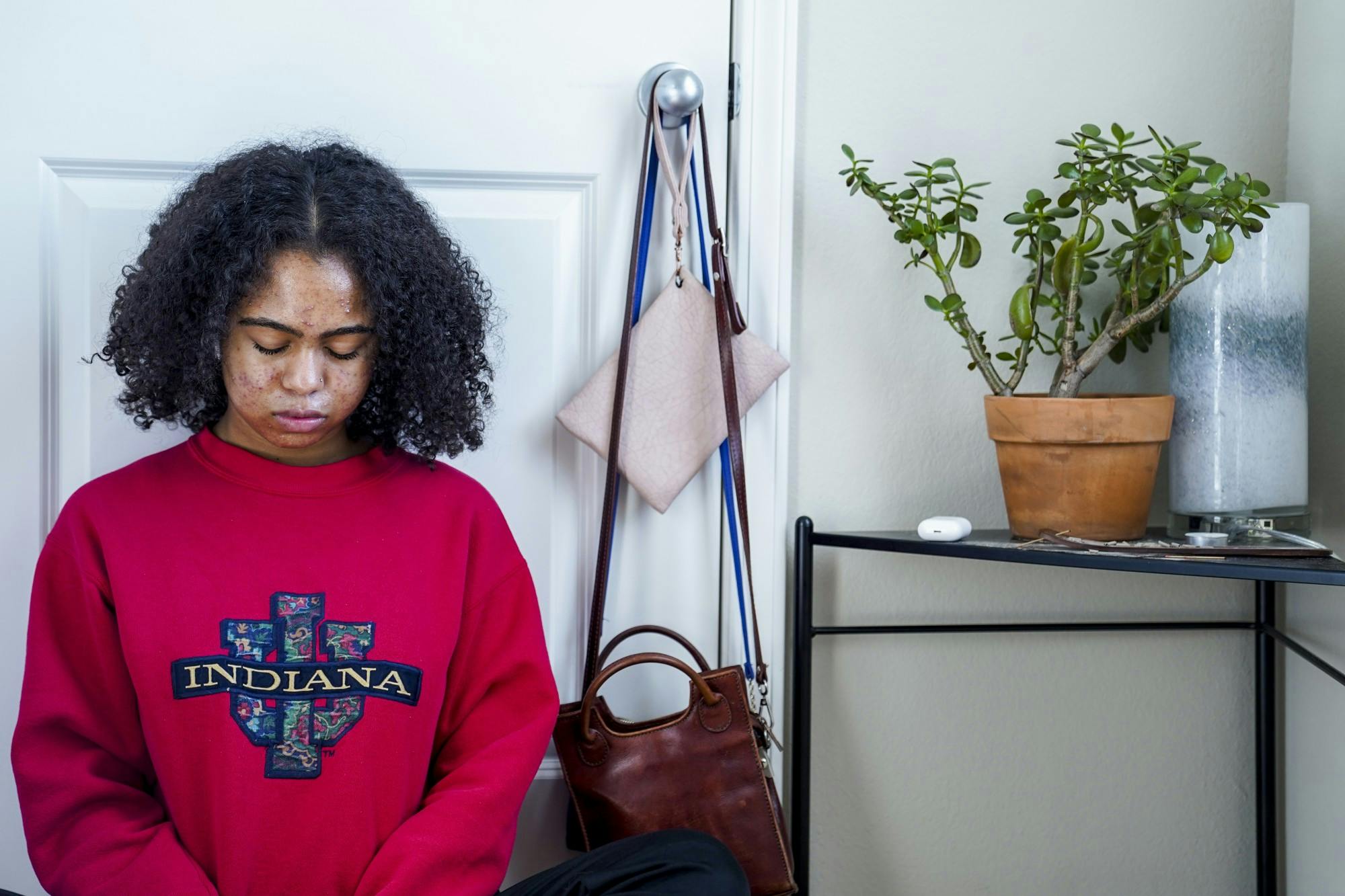
Claire Livingston | IDS
Aluko does her morning meditation Nov. 6 at her apartment. She perfers to mediate in the morning to get a good start to her day and to do it while there are fewer distractions.
She brushed off the comments, thinking they probably just were saying that because IU is predominantly white. Alice was confident about being around white people. She was half white herself. Growing up, she’d visit her mom’s family in rural areas such as Mooresville and Whiteland, Indiana. She had plenty of white friends. She knew how to act around white people, she told herself.
But growing up in a diverse community affected Alice more than she thought. Pike Township, where she went to high school, is majority Black with a significant Hispanic population. Having a father who was Nigerian and a mom who was white was not unheard of in her community.
The Alukos attended St. Monica Catholic Church every Sunday and every holy day without fail. St. Monica’s, one of the most diverse Catholic churches in Indianapolis, is a tight-knit community where Alice witnessed the importance of compassion in the church’s efforts to help refugees. Her parents loved and protected her. Alice knew what it felt like to be looked at too long or given dirty expressions, but overt racism was never a part of her life until she moved to Bloomington.
Alice’s freshman year started off well. She was making friends and having fun. But she and Massa Massaley, her freshman roommate who is also Black, immediately noticed the sea of white faces and the Blue Lives Matter and Confederate flags on trucks at gas stations. Massa would wonder why the university hadn’t recruited more students from Black communities.
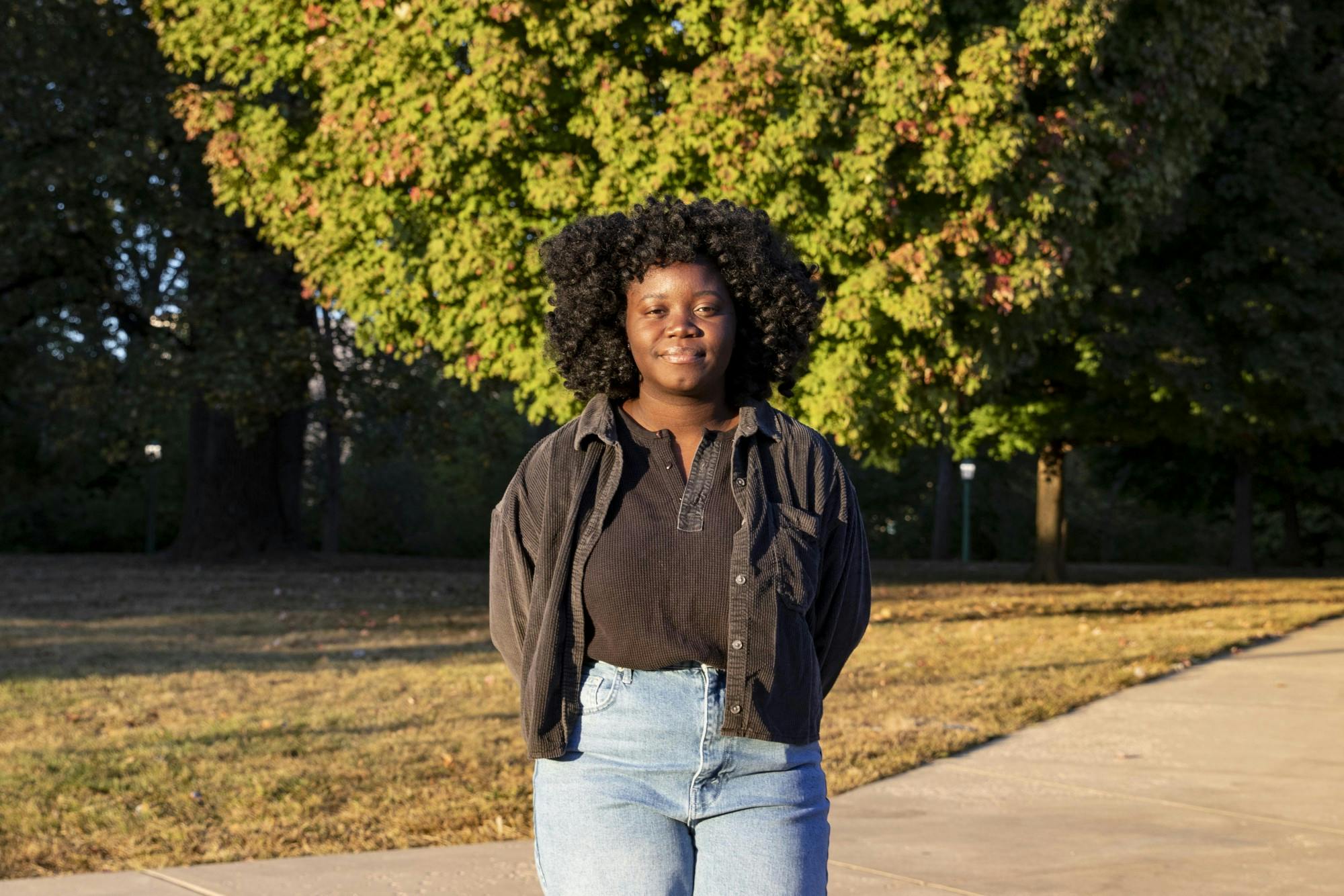
Alex Deryn | IDS
Junior Massa Massaley stands in the sun Oct. 5 in Bloomington. Massaley is a Black student at IU and has experienced acts of bias alongside her best friend Alice Aluko.
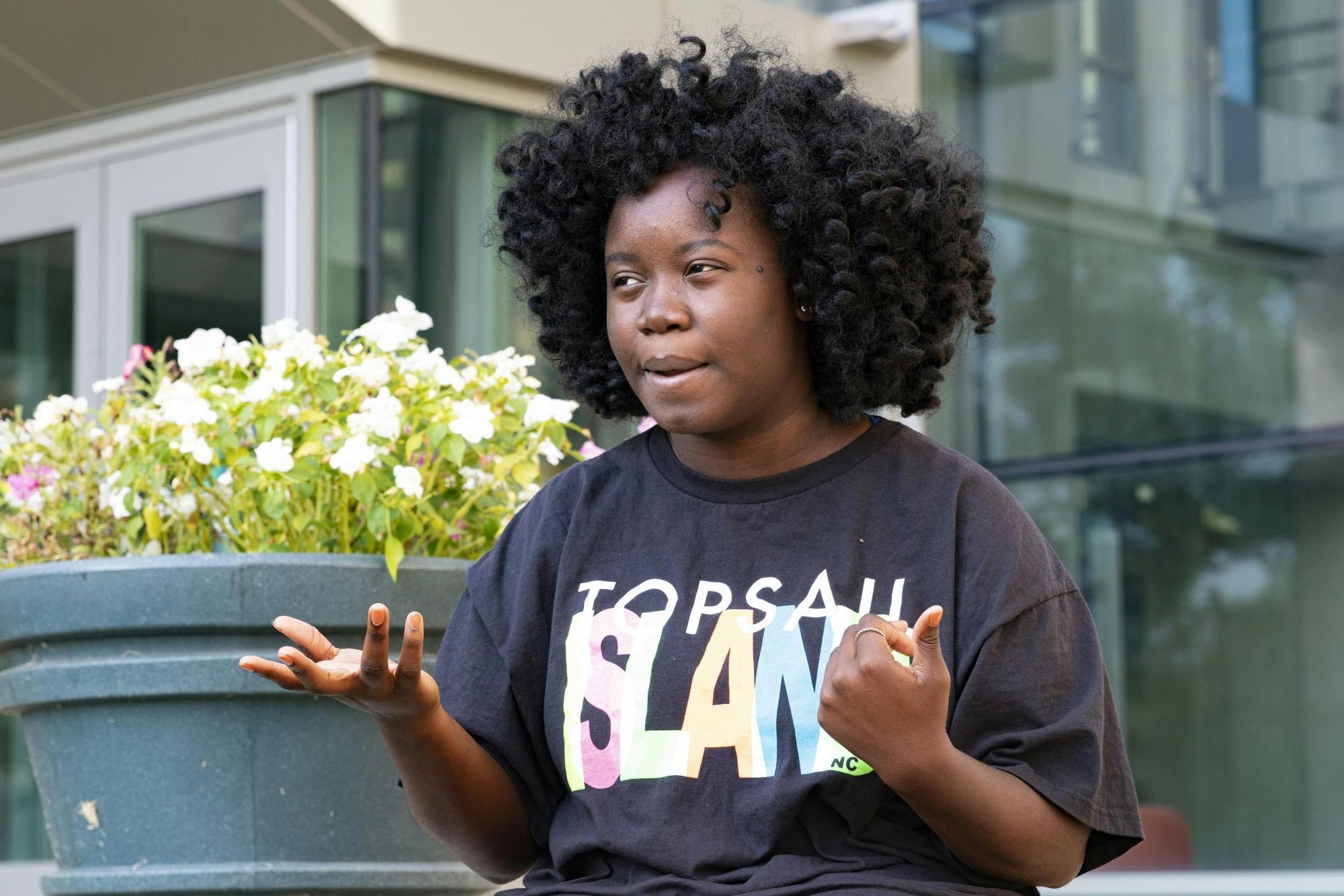
Alex Deryn | IDS
Junior Massa Massaley explains what it feels like to go to Indiana University as a Black student Oct. 6, in front of the Global International Studies Building in Bloomington. “Being Black is like being very hyper visible but at the same time being invisible,” she said.
“Very often, our main friends who were students of color, they were all here at IU through the same scholarships we were on,” Massa said. “Very often, we had to think, is this just a quota that the university has to fill when it comes to their measurements of diversity?”
In classes, Alice and Massa would sometimes be ignored, interrupted and excluded by other classmates. They’d double check themselves before raising their hands and doubt themselves afterwards.
Did what I just say make sense? Did I perform as well as my white peers? Did the professor understand me? Did I come off as aggressive? Did I come off as friendly?
On the way to one class where she was routinely interrupted and dismissed, Massa would shake from anxiety. She felt like her Blackness stood out when she walked into the room. It made her want to hide.
“Being Black is like being very hyper visible but at the same time being invisible,” she said.
In mid-January of her freshman year, Alice walked from the last class of her day, U.S. Policy and Administration in Rawles Hall, to the law school bus stop on Third Street. She usually walked with two friends from her class, but that day, they weren’t there.
A crowd of 50 to 60 students stood around her at the bus stop. Alice heard a commotion coming from down the street and people began to turn and look at her. All of a sudden, a white, middle-aged man with red hair, a beard and worn clothes lunged a few inches from her face.
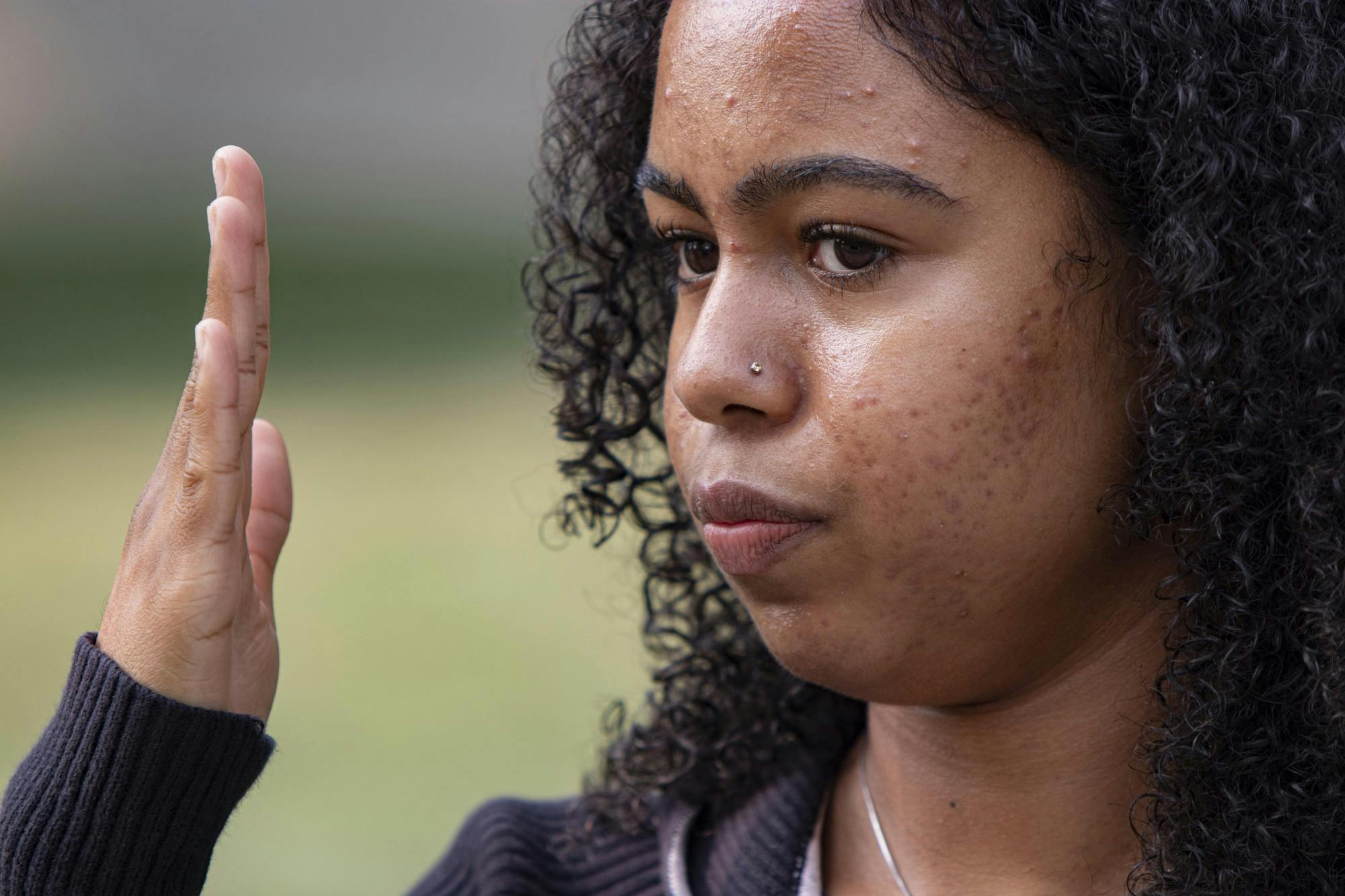
Alex Deryn | IDS
Junior Alice Aluko describes the act of bias she experienced her freshman year at IU on Sept. 15 at the corner of Third Street and Indiana Avenue. Aluko shows how close the verbal attacker was to her face with her hand.
“There’s a majority here!” she remembers him yelling. “Do you understand me? Do you understand me?”
She stared at him, frozen and stunned. He turned to two white students who stood nearby who were laughing.
“You think it’s funny?” he asked them. “You’re the ones who should care.”
Then the angry man turned and charged down the sidewalk, continuing to yell.
Ten minutes later, she boarded the bus, still stunned. It wasn’t just the horrible things the man had said or the way the two other students had laughed. Not one person in the crowd at the bus had said anything to the yelling man, warned Alice he was approaching her or asked if she was OK afterward. Although the shouting man was scary, the lack of action from the other students was what stuck with her. She felt completely invisible.
Alice immediately texted Massa when she sat down on the bus.
Massa had known Alice since they were in high school where they became fast friends in choir. Her friend sang everywhere she went, was funny, independent and down to earth. When Alice walked through the door to their dorm room at Eigenmann Hall that afternoon, she was not at all herself.
“When Alice had the situation on Third Street, it broke her heart,” Massa said.
Massa understood how upsetting these incidents were. A stranger had called her the N-word in Eigenmann’s lobby one day, and a woman had demanded she prove she was a student one night when she was studying in the Indiana Memorial Union. But as upsetting as these overt attacks were, Massa and Alice agreed that the everyday, less obvious experiences of racism cause even more emotional harm than overt racism.
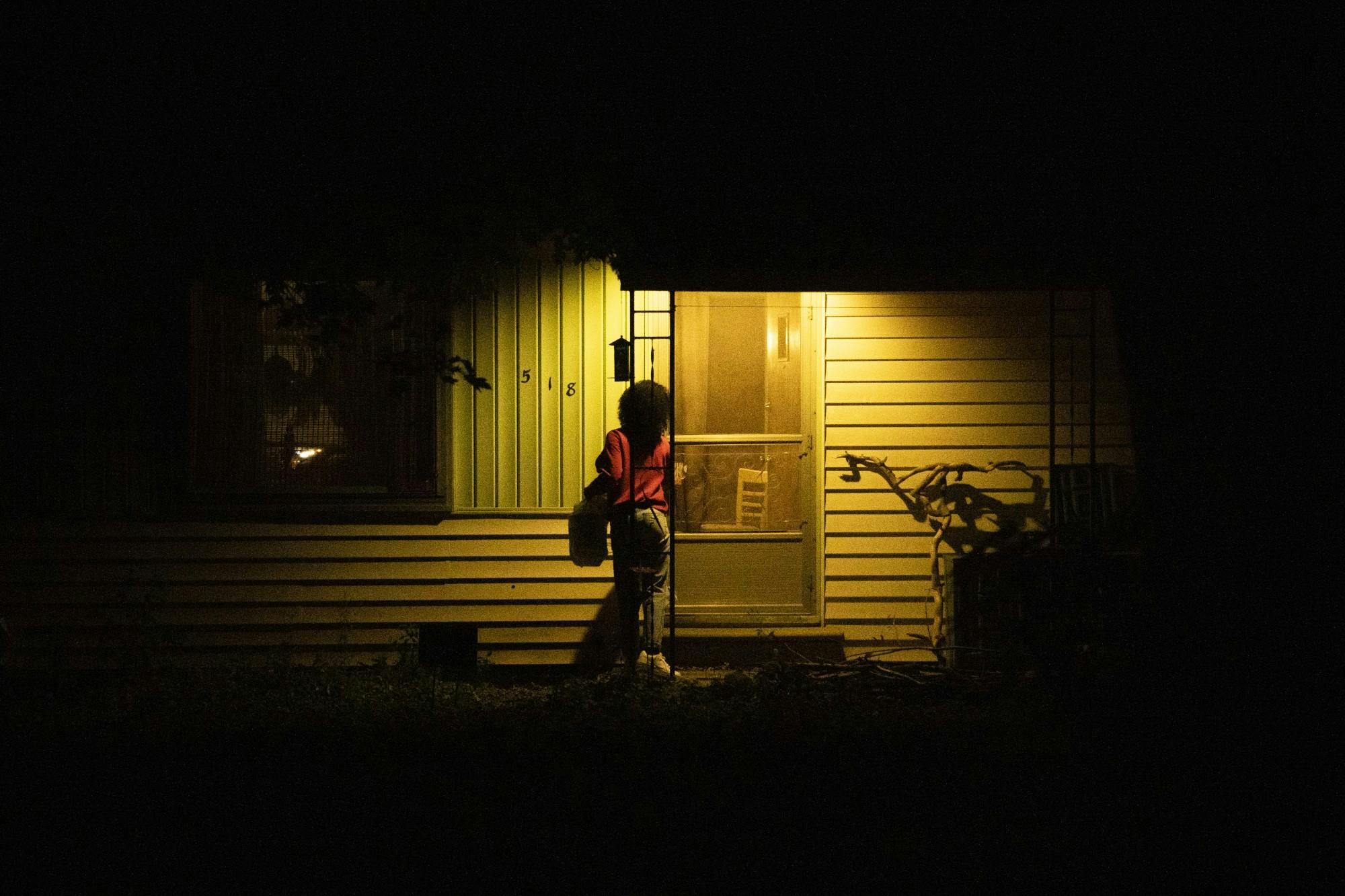
Claire Livingston | IDS
Aluko knocks on a customer’s door Sept. 18 while delivering for DoorDash, a food delivery service. The homeowners stared at her and ignored the door for a few minutes before taking their order.
They happened so often, they started to ignore them: people giving them dirty looks, workers or even other customers following them around in stores, always being checked on by a worker at the self-checkout, not being offered help when in obvious need of help. And they’re often gaslit if they bring it up.
Later on the night of the bus stop incident, Alice saw in the Black IU GroupMe that other Black students had encountered the man too. A video began circulating on Twitter the same day of the man walking and yelling, “I’ll kill your children. You’d better recognize there’s a majority around here.”
She called her mom to tell her about what happened. Her mom cried. You can transfer to IU-Purdue University Indianapolis, her mom said, urging her to report the incident to the police. After her dad heard about the incident, he had trouble sleeping.
When Alice texted her parents to tell them she was being interviewed for an Indiana Daily Student story about the verbal attack, her dad advised her: Don’t say anything that will make people target you. Be calm and collected.
She was later told by police that the man who yelled at her was experiencing homelessness and hadn’t been taking his medications. An administrator said if police found him, he would be advised of trespassing.
Alice quickly saw the incident as a rite of passage, something many Black students experience at IU.
This is your first experience, she told herself. It probably won’t be the last, and it probably won’t be the worst.
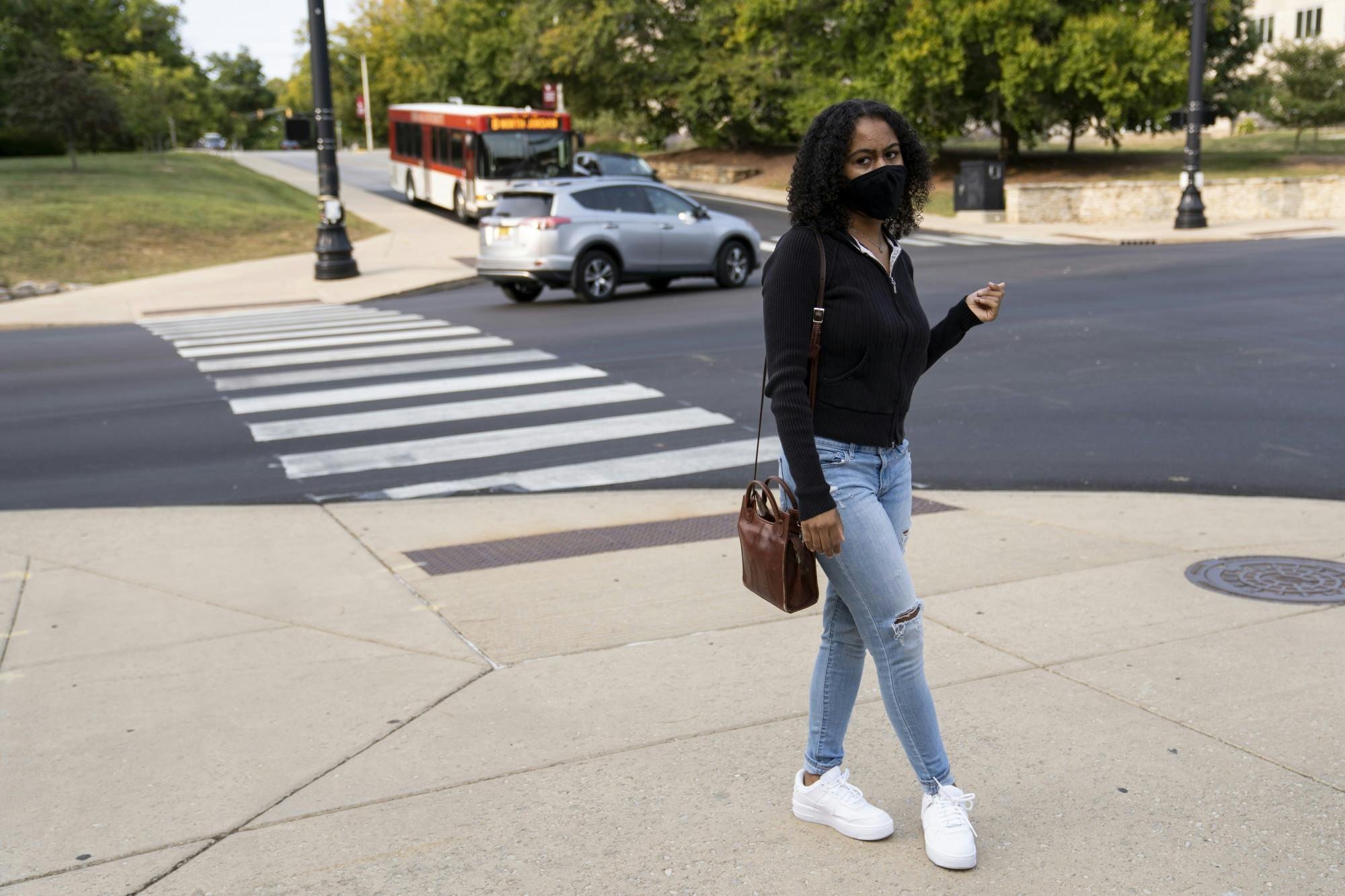
Claire Livingston | IDS
Aluko talks about the second bias incident that also happened during her freshman year of college. Afterwards, she tried to not walk home later at night by herself in order to avoid anything like that happening to her again.
Three months later, she was leaving Herman B Wells Library one evening in the dark, waiting to cross Jordan Avenue. A man coming from North Jordan in a shiny, white pickup truck with a noisy engine yelled the N-word at her out of the passenger window. There was nobody else at the intersection.
The feeling of shock came again, rooting her to the sidewalk. Unable to process what was happening, she didn’t catch a license plate number and the tinted windows hid the man’s face.
In the weeks after the incident, she saw the shiny, white pickup with the loud engine multiple times on Jordan Avenue. Each time, she couldn't seem to catch the plate number. She never saw the driver’s face.
She reported both the Third Street incident and the incident by Wells Library to the school, the first through the IU Police Department and the second through IU’s bias reporting form. Cedric Harris, director of bias response, emailed her in response to her report about the white truck, as he always does when students report.
Hello Alice,
Your bias incident report was received. It is unfortunate that you had to experience this incident as you were leaving the library. Reporting incidents of bias, hate, harassment or discrimination via this reporting system helps to create awareness to influence change on campus.
He went on to ask if she wanted to meet to talk about the incident and determine if she wanted to take further action.
But Alice was too tired from processing the bus stop incident to think about trying to take action on the shouted slur. She didn’t think the school could do anything about the mysterious white truck, but she thought reporting it was important. Maybe if it happened to someone else, they could connect the dots.
After the turbulent second semester of her freshman year, Alice wondered if she had made the right choice in attending IU.
It would have been hard to leave, though. All of her friends were at IU. What happened to her could happen anywhere, she reasoned. Any predominantly white institution was a little racist. But most of all, Alice didn’t want the fear to prevail.
“I’m just letting these people win if I leave this school,” she said. “That’s what they want.”
Advertisement
***
IU and the City of Bloomington have always had a problem with racism. Black students couldn’t eat at most Bloomington restaurants until 1950 when Herman B Wells demanded restaurants serve them. The KKK still drops off flyers around town and gathered publicly in nearby Madison, Indiana, for a cookout last year. Only in the past two years has the university stripped names off of IU buildings and landmarks of people who had openly racist views.
In 1988, Pam Freeman, former assistant dean of students, and Bill Shipton, a former director in student services, created the Racial Incidents Team and other teams were later added for other types of bias. The creation of the teams didn’t come without pushback from some university leaders.
“People thought if you do these teams, it’s going to bring attention to these incidents, which is going to make IU look bad,” Harris said.
Harris worked for IU’s Residential Programs and Services for 24 years and was on the racial incidents team before the school decided to streamline all the bias reports to the position he holds now.
Over his years of reading reports, Harris said the cases haven’t changed much. Swastikas drawn on dry-erase boards, people shouting slurs down streets and careless mentions of slavery in classrooms — racism on campus is somewhat predictable to Harris.
Sometimes, Harris has to shift administrators' gazes from incidents that go viral on social media to cases in classrooms that can be much worse. Every two weeks, Harris meets with his supervisor, Kathy Adams Riester, associate vice provost for student affairs, about recent reports. If incidents are extreme enough, they are reported up to other administrators.
Student narratives are a way for administrators to visualize how systemic racism manifests on campus, Harris said. He hopes, at minimum, the stories spark conversations among the school’s leaders and influence their decision making.
Harris recounted how IU President Michael McRobbie has written multiple times that there is no place for racism on campus, most recently after the killing of George Floyd. He shrugged. The reports of bias have not stopped.
“It’s hard to enforce that strong statement, ‘We will not tolerate it,’” Harris said. “That means we won’t tolerate it, period. But we don’t operate that way unfortunately because it’s more difficult in practice than to say it.”
***
How racism has shaped IU students’ college experience
Alex Deryn and Claire Livingston | IDS
Juniors Alice Aluko and Massa Massaley have both experienced racism at IU. Aluko and Massaley would sometimes be ignored, interrupted and excluded by other classmates while attending classes. Aluko knew there would be racism at IU, but the reality was worse than she expected. Massaley has followed Aluko on the same journey while providing comfort and support as a fellow Black student.
After the two incidents, Alice’s happy-go-lucky approach to socializing that she had started the year with was gone. The summer after her freshman year, her boyfriend bought her a pink taser for her birthday. He, like her parents, was worried about her safety. She only went to Black parties, Black events and only made an attempt to make friends with Black students in her classes.
What was the point in trying to make new white friends, she thought. She knew not all of them were racist, but it was too much of a risk. She didn’t want to be hurt again.
The pain hit her hard when she started her sophomore year. She felt isolated, even though she lived with three roommates. On campus she still felt invisible. Her apartment windows faced an alley, and it was always dark inside. She needed light.
She started going to therapy and felt comfort in having a Black woman as a therapist who could understand her day-to-day life. She began to be more intentional about mindfulness and prayer. She hung out with friends who understood what it felt like to often be the only person of color in a classroom.
But this past summer was another blow to her mental health. She saw the news of Ahmaud Arbery, Breonna Taylor and George Floyd, but for her it all started with Dreasjon Reed, a 21-year-old who was shot and killed by Indianapolis Metropolitan Police Officer Dejoure Mercer just down the street from her parents’ home.
She didn’t know Reed personally but knew people who did. He was shot just outside her church, the library she grew up going to, her little brother’s old Montessori school and the taco truck where she’d go with friends on late summer nights. The night he was killed, the sirens didn’t stop.
Alice went to protests in Indianapolis and was inspired at first by the energy of activism. But she soon got emotionally burnt out and annoyed with white people for going to protests for the wrong reasons and posting on social media just to look good. She overheard white people at one protest say they were looking forward to breaking windows.
Every time Alice drove past the place where Reed was killed, she saw his shrine in the library parking lot. The area that felt so familiar now felt eerie.
Unrest also brewed in Nigeria, where some of her dad’s family remained. People took to the streets to protest the Special Anti-Robbery Squad or SARS, a police force notorious for its brutality. Police opened fire on protesters Oct. 20. She messaged family members in Lagos. The government had called for everyone to stay inside. They were scared.
As a summer of unrest faded into a fall of election anxiety, rumors flew about white supremacists planning killing sprees during election week. The NAACP said the rumors were baseless, but Alice’s Twitter, TikTok and group chats were still filled with instructions from her Black peers: Don’t go out past sundown, stay in groups, pack a safety bag in case you need to leave quickly.
Alice’s cousin who lives in California and is also multi-racial texted Alice to check in. She was stocking up on groceries and gas and was worried about Alice. She sent money through Venmo to Alice so she could fill her tank. She mapped out a route for Alice to get home to Indianapolis without going through Martinsville, a town notorious for racism.
Her parents vowed to move to Europe if President Donald Trump was reelected. Her little brother is only 10, but her parents are already worried about him living in a country where young Black males are so often the target of police violence.
Neither Alice nor her cousin knew what was going to happen the next day or the days after, but they braced themselves for the worst.
Advertisement
***
Harris can easily feel overwhelmed by his job if he doesn’t take time to step away.
Even though he feels like he’s doing something important by giving students a space to share their story and be believed, the feeling of powerlessness sometimes creeps in. He can help students file police reports, report faculty and staff bias to their supervisors, but he can only do so much for the many students who don’t know the identity of the person who did the bias act.
But he knows the worth of the data the reports create. His ultimate goal is to post monthly updates on the school’s website with general data about bias reports he receives as well as semesterly and yearly reports that give a bigger picture of numbers and trends.
Reports like this used to be put together every semester by the administrators who started the bias response teams in the late 80’s. But when Freeman and Shipton retired in 2012, the reports stopped because of a lack of initiative, Harris said. Harris hopes to have his first report ready within the next year. He sees transparency as the next step towards making campus a safer place for Black students.
Harris got his bachelor's degree at Stanford University. Diversity was a part of the culture there, and when he came to IU for law school, he didn’t see that. There were Black, Latinx, Asian and other ethnic and cultural groups on campus, but they didn’t mix often.
“You could tell everything was separated,” Harris said. “There were all these little pockets.”
A part of Harris’s job is to talk to students who are accused of committing acts of bias. The school takes an educational approach to most incidents of bias when only students are involved. Once, when a Black student was yelled at by a man in a car with an IU parking sticker, they were able to identify the man as a contracted employee and he was fired by his company. But Harris said it is difficult to expel students for bias.
“A lot of this stuff is just someone’s opinion or their impression or they say some horrible word, and in the United States you can say horrible words,” Harris said. “They don’t feel good when you hear them, but you can say them.”
The majority of time, Harris thinks students are changed by the discussions he has with them. He tries to help them understand the pain they’ve caused the other student. Many times, he thinks just the act of meeting with students makes them take the incident seriously — he can see it in their faces.
***
As Alice and her roommates drove to get gas the day before the election, they talked about what was going to happen. Alice voted by mail because she was registered in Indianapolis. They all wanted to go home and be with their families on election night, but jobs got in the way. Alice’s roommates promised to pick her up the next day after her shift at the Graduate Hotel ended at 8 p.m.
She turned on her taser so that it would be ready to use and put it in her pocket like she always does at gas stations. She asked her roommates to come into the building with her to pay. Between the Trump flags on trucks and people giving her nasty looks, Alice never feels safe getting gas.
The next night, Alice and her roommates stayed up watching the results come in, but it was soon clear the night would be anticlimactic. She went to bed anxious. She prayed quietly while she got ready for bed, thanking God for protection and moments with friends that day and asking him to watch over her, her friends and her family for the rest of the week.
For the next four days, life was in limbo for all of America as votes were counted. Alice thought Trump had a high chance of winning. She had resigned herself to more mental exhaustion, more disappointment. But as more votes were counted, her hopes for Joe Biden winning increased.
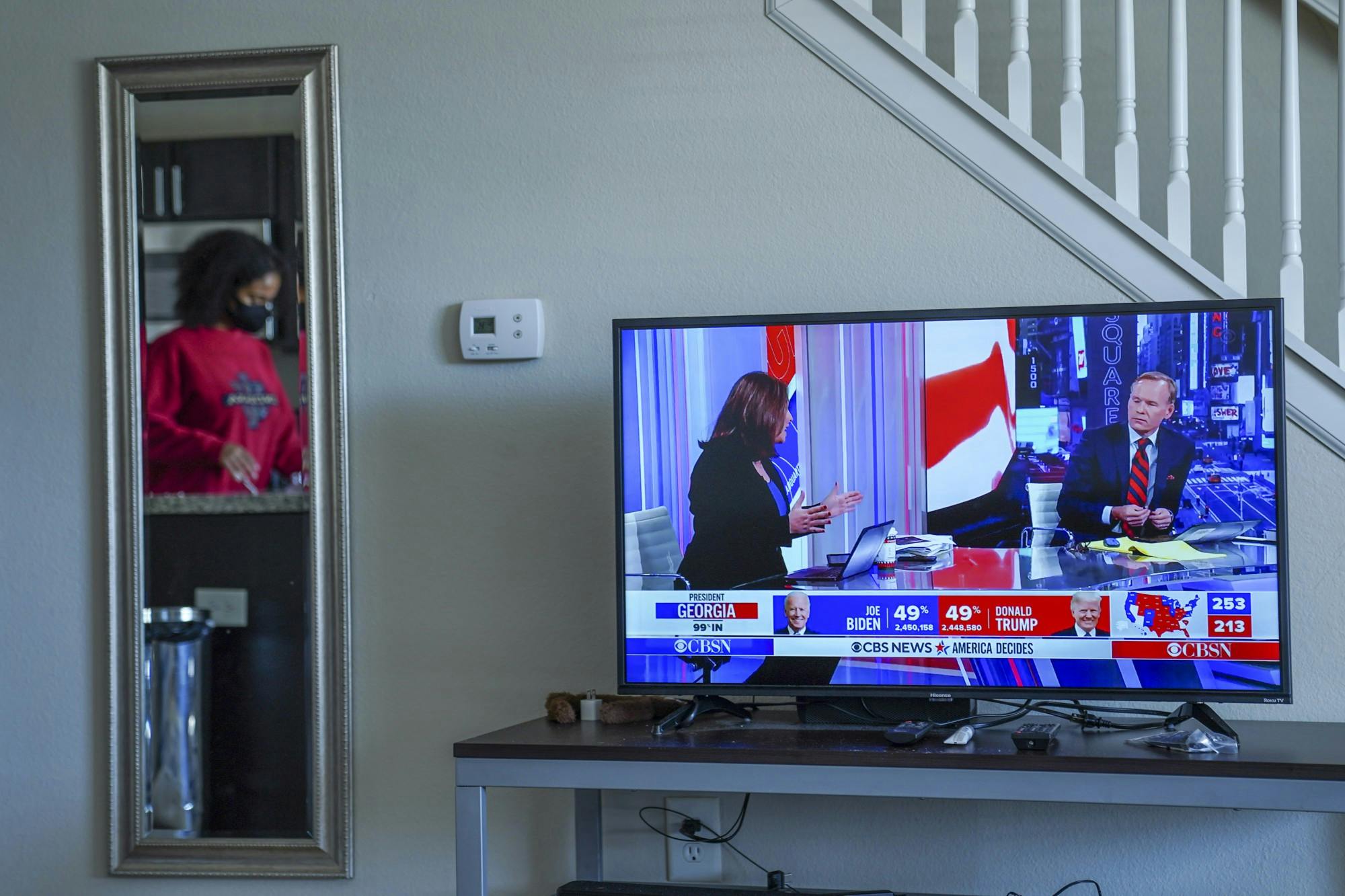
Claire Livingston | IDS
Aluko does the dishes and makes herself some tea as she listens to CBS News. During this time, the presidential election was too close to call in certain states such as Georgia.
On Saturday morning, news notifications went off on cell phones across the country: the Associated Press had called Biden as the winner. Alice was relieved.
She watched Twitter explode and people on TV celebrate. She saw Black CNN commentator Van Jones break down in tears on-air.
“This is vindication for a lot of people who have suffered,” Jones said. “You know the ‘I can’t breathe,’ that wasn’t just George Floyd, that was a lot of people that felt they couldn’t breathe.”
She knew exactly what he was talking about. If the past year had taught her anything, it was that racist people had become very comfortable openly showing their beliefs.
A week later, a grand jury announced that Indianapolis Metropolitan Police Officer Dejoure Mercer would not be charged for the shooting of Dreasjon Reed from lack of evidence. Alice was once again disappointed but not surprised. She thought of the little shrine for Reed in the library parking lot.
Over the past year, the country has been faced again and again with a harsh reality: Racism is still embedded in American society. During her time at IU, Alice has come to the same realization.
To Alice, racism at IU cannot be stopped only by bias reports or trainings. She doesn’t know the solution and neither does Harris. Both think the university could do more to prevent racism and educate incoming freshmen about race. Above all, Alice will always think about the white students who stood silently aside as the red-haired man screamed at her at the bus stop.
“There was so many chances they had to talk to me, at least one person, and no one did,” she said. “And that, to me, was just a clear indication: There is no unity here. You’re on your own.”

Claire Livingston | IDS
Aluko crosses her legs and sits in the corner for her meditation. Aluko perfers to listen to music while she meditates rather than do a guided meditation.
Like what you're reading?
Support independent, award-winning student journalism. Donate.
© Copyright 2020 Indiana Daily Student
